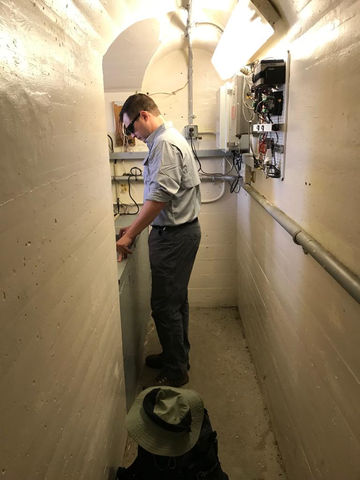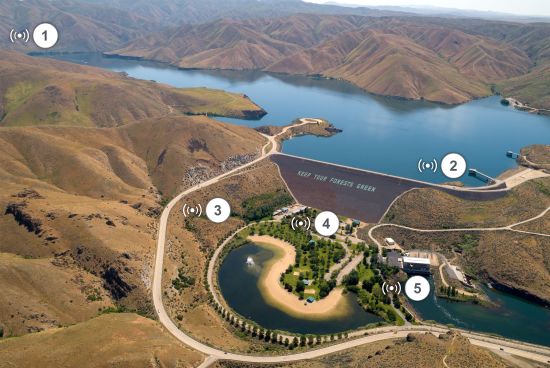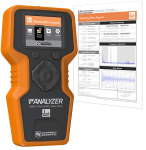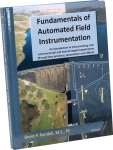我们做什么

Measurement automation platforms are unique to each dam because of the many types of measurements they are required to collect. Our platforms can measure all the parameters required for a successful dam monitoring program, including, but not limited to, water level and flow, strain, and vibration. In addition to real-time data measurement, each measurement device will alert you of changes in factors such as water level, load, pressure, and tilt if they move beyond acceptable ranges. Historical and real-time data can be transmitted directly to the cloud or to your PC. Measurement automation platforms are rugged, low power, and adaptable to the harshest, most remote environments.
-
Reduce the uncertainty. Using automated measurements for data integrity, security, quality control, and local alarming capabilities, our systems are built to reduce your project uncertainty.
-
Make your operations more efficient. Our systems are designed to make your measurement automation setup and long-term operation simple and fast.
-
Get high performance, no matter the size, with scalability. We offer platforms to accommodate your small, single projects to large-scale, multi-site operations.
-
Benefit from the flexibility of an open ecosystem. You can own your data, own your network, and control your configuration with capabilities to plug and play, self configure, and interface with any commercially available sensor.
-
Share your data. Powerful reporting, dashboard building, and built-in data-sharing tools keep everyone informed, including your stakeholders.
Allow our team of experienced application engineers to make this easy as they help you build a dam monitoring system specific to the measurements you need.
Learn about our patented VSPECT® spectral-analysis technology at our VSPECT Essentials web resource.
Learn about dynamic vibrating wire sensor measurements at our Dynamic Vibrating Wire web resource.
The dynamic vibrating wire measurement technique is protected under U.S. Patent No. 8,671,758, and the vibrating wire spectral-analysis technology (VSPECT) is protected under U.S. Patent No. 7,779,690.
Unlock the power of instrumentation and monitoring with our various geotechnical training options.
了解更多有关更多详细信息我们 大坝监测 - 结构性能 系统

- Precipitation and inflow
- Reservoir level
- Slope stability
- Seepage
- Outflow
Dam Measurement Automation Platforms
The versatility of our platforms allows them to be customized for each application. We offer a range of platforms, from the most basic device with just a few channels to expandable platforms that measure hundreds of channels. Scan rates can be programmed from once every few hours to 10,000 times per second, depending on the model. Measurement types, processing algorithms, and recording intervals are also programmable.
The measurement automation platform has a simple, yet powerful on-board instruction set: simply choose the sensor type, scan rate, and measurement channel. On-board mathematical and statistical processing allows data reduction in the field and enables measurements to be viewed in the desired units, whether that is microstrains, centimeters per second, revolutions per minute, meters, Amperes, or inches.
The versatility of the measurement automation platform extends to control as well. Each platform can monitor and control external devices based on time or measured conditions, allowing savings in time and equipment, and warning of—or possible prevention of—dangerous conditions. Our platforms automate alarm activation according to a pre-defined Trigger Action Response Plan (TARP) if measurements reach set thresholds. These platforms are rugged enough to be used in dams worldwide.
The measurement automation platform can stand alone. Once programmed and powered, no human or computer interaction is required, although data are typically downloaded to a PC or exported to the cloud for further analysis. A telecommunications or hardwire link allows critical data to be monitored and graphed in your office 24/7 rather than only in the field. Data from various stations and applications can be monitored from a single laptop or desktop computer.
The low power drain typically allows our platforms to be powered by solar panels and batteries. If 110/220-Vac power or external 12-Vdc batteries are available, you can use those as well. Non-volatile data storage and a battery-backed clock ensure data capture and integrity.
Training
Campbell Scientific offers training courses that can be conducted at your location and customized to meet your specific needs. Hands-on training with our engineers helps ensure your system provides the site condition data you need today and into the future.
Sensors Used for Dam Measurements
The versatility of our measurement automation platforms begins with sensor compatibility. Our platforms can measure virtually every commercially available sensor, allowing them to be used in different ways for a variety of measurements. For example, the following are common parameters that the sensors in our platforms measure:
- Pore water pressure
- Water level
- Water flow
- Settlement
- Displacement
- Strain
- Stress
- Tilt
- Inclination
- Weight
- Force
- Pressure
- Deflection
- Barometric pressure
- Temperature
- Humidity
- Elevation
More specifically, these are the sensor types commonly used in our measurement automation platforms:
- Piezometers
- Pressure transducers
- Inclinometers
- Tiltmeters
- Settlement sensors
- Borehole pressure cells
- Earth pressure cells
- Load cells
- Pressure cells
- Accelerometers
- Vibrating wire strain gauges
- Foil-bonded strain gauges
- Extensometers
- Jointmeters
- Crackmeters
- Strainmeters
- Deformation meters
- Barometers
- Pressure cells
- Tilt beams
- Stressmeters
- Thermistors
- Thermocouples
- Deformation sensors
- Radar water-level sensors
- Sonic water-level sensors
- Displacement transducers
- Linear variable differential transformers (LVDT)
Because our measurement automation platforms have many channel types and programmable inputs, all these sensor types can be measured by one device. Channel types include analog (single-ended and differential), pulse counter, switched excitation, continuous analog output, digital I/O, and anti-aliasing filter. Using switched or continuous excitation channels, our platforms provide excitation for ratiometric bridge measurements.
The following are common sensor measurement types that our measurement automation platforms are compatible with:
- Frequency
- Resistance
- Voltage
- Ratiometric
- Current
- Modbus RTU
- RS-485
- SDI-12
- RS-232
Communications
The availability of multiple communications options for retrieving, storing, and displaying data also allows platforms to be customized to meet your exact needs. Onsite communications options include direct connection to a PC or laptop, PC cards, storage modules, and platform keyboard/display. Telecommunications options include short-haul, telephone (including voice-synthesized and cellular), radio frequency, multidrop, and satellite.
案例研究
In the mountains of Antioquia, Colombia, eight of the region’s most important dams now share......阅读更多
Overview The reconstruction of the navigational lock system at the Iron Gate I Hydroelectric Power Station......阅读更多
Background Think of the First Transcontinental Railroad. Minor errors in surveys and maps could have led......阅读更多
Background Tailings dams are crucial components of mining operations, responsible for storing water used in the......阅读更多
Levees are used in every state in the US with a higher concentration in states......阅读更多
Natural disasters occur everywhere, and California is no exception. When wildfires were rampant across the......阅读更多
When the Ohio Department of Transportation (Ohio DOT) was preparing to widen Interstate 77, they......阅读更多
The Norwegian company ITAS (Scanmatic Instrument Technology AS), started as part of the Research Council......阅读更多













